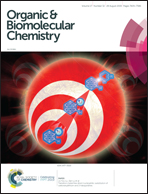|
Autors/es
Revuelta-Maza, M.A.; Nonell, S. ; de la Torre, G.; Torres, T. ; de la Torre, G.; Torres, T.
|
Abstract
In-depth, systematic photophysical studies have been performed on a series of ABAB, A3B and A4 ZnPcs functionalized with a varying number of bis(trifluoromethyl)phenyl units (i.e. at the B isoindoles) and other electron-withdrawing/electron-donating moieties (i.e. at the A isoindoles), to determine the influence of the susbtitution pattern on the aggregation features, fluorescence quantum yields and singlet oxygen (1O2) generation abilities of these molecules. As a general trend, the larger the number of bis(trifluoromethyl)phenyl units (i.e.ABAB crosswise functionalized ZnPcs), the lower the fluorescence quantum yield and the higher the 1O2 photosensitization. On the other hand, the electronic character of the substituents at the A isoindoles do not seem to have a clear effect on the photophysical properties of these ABAB ZnPcs. Overall, 1O2 quantum yields determined by the direct observation of the 1O2 phosphorescence are very high, with values ranging from 1 to 0.74 in THF solutions.
|

WoS
Scopus
Altmetrics
  
|
|
Publicació
Organic & Biomolecular Chemistry, 2019, vol. 17, no. 32, p. 7448-7454
|
